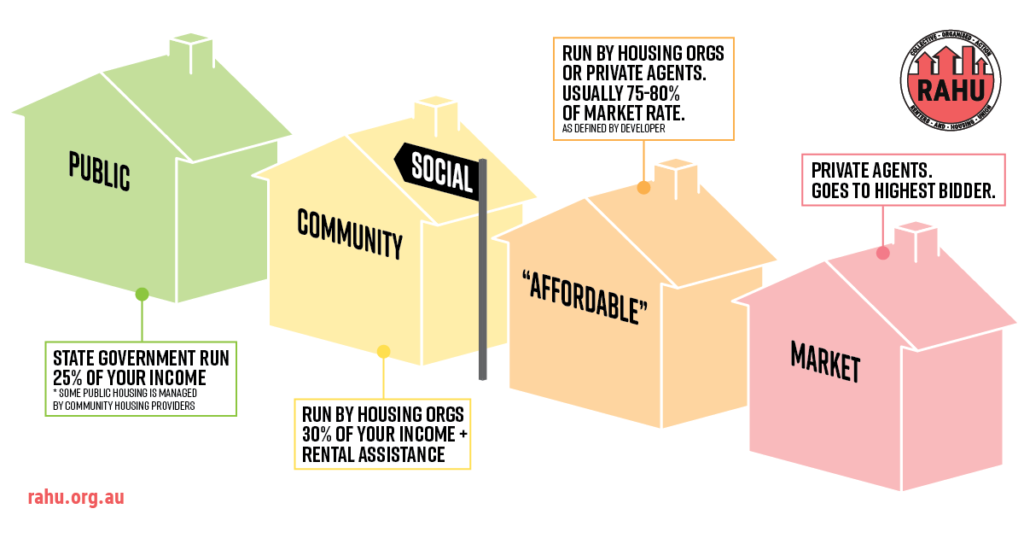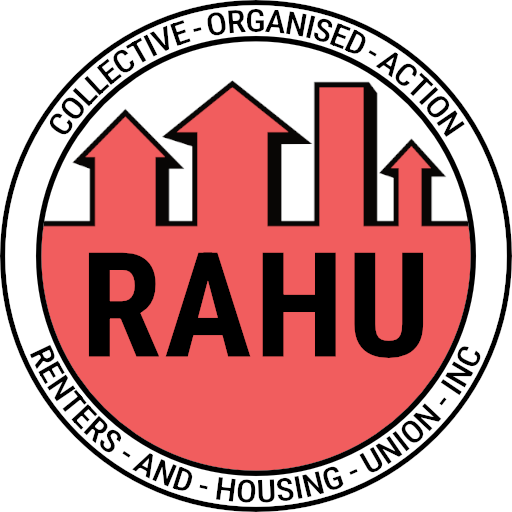Public, social, community or affordable? Demystifying housing terms in Victoria

If you’ve dipped your toe into housing policy you’ve likely come across a bunch of terms: public, social, affordable, community. This is a quick explainer to help you tell them apart (and help pick up on bullshit neoliberal claims from politicians).
Types of housing in Victoria
The gold standard: Public Housing
Public housing is managed by the state government. Rent is capped at 25% of your income (no matter what that income is, including Centrelink).
There is currently a massive shortage and a huge waiting list, but if you can get in, it’s the most secure tenure type. [2]
This is what RAHU is calling for more of. Quality, well-located public housing that is affordable to anyone, where you can’t be kicked out for no reason.
A little bit of a smokescreen: Social Housing
The term ‘social housing’ encompasses both public and community housing. The public housing part is good, but underfunded. The community housing part can be a good opportunity for people on low incomes, but it’s less secure and it’s run by private companies, so you can’t expect as much security as you would in public housing.

This chart from the Australian Institute of Health and Welfare shows that the proportion of ‘other’ social housing is growing. Less housing is run by the government and more by private companies. Some of this is because of the Public Housing Renewal Program currently underway. These housing estates were left to decay, and now the government is taking tenders from industry to ‘renew’ public housing estates. This ‘renewal’ involves turning them from 100% public housing into a mix of social and affordable. This means a developer building on public land and make a profit, displacing residents, which never has good results, and even a projected decrease in the number of bedrooms available for social housing tenants.
Eh, it depends: Community Housing
I think it’s important to note that people who work at community housing providers are generally well-intentioned and excellent at their jobs. Unfortunately, they often have to do their job with scarce resources, and they too can’t provide a home for everyone who needs one.
In addition to this, while a community housing estate is either owned OR managed by a not-for-profit organisation, the estate is often owned by a large property developer, which is how we end up with the “social mix” model of some community houses and many private tenancies, to keep the building profitable.
Our members who have lived in these buildings say that there is very little accountability from the property agency, and very little accommodation of vulnerable tenants’ needs. It can get murky, too, what type of tenancy you’re on in a mixed building because of how it’s advertised. Members have told us they believed they were signing up for community housing until they found themselves paying 65% of their income to rent, because they were in fact on a private tenancy in a community building.
Community housing gets funding from government grants, government loans, deals with councils, philanthropy, social impact investment and clever leveraging of capital (such as their existing buildings).
Rents for a real community housing spot, if you make it through the waitlist, is capped at 30 percent of the combined gross incomes of all members of the household, plus any Commonwealth Rent Assistance (CRA) to which the tenant is entitled.
Yes, you read that right – rent support from the government is funnelled directly into these private businesses, but it doesn’t count towards the income payments.
A straight-up lie: Affordable Housing
When someone talks about “affordable housing”, they might mean housing that is genuinely affordable (less than 30% of someone’s income) – or they might be using the industry definition. Depending on who you talk to, “affordable” dwellings are set at 75 – 80% of the market rate. The thing about the market rate is that it’s really bloody high.
Often a big developer will be lauded for providing affordable units as part of their development, when really they’re not affordable for someone receiving income support payments.
The shark tank: Market Housing
If you’re not eligible for social housing[1] or you can’t wait that long, welcome to the private tenancy market.
You know the market I mean: you dress up in a tuxedo to impress the property manager at the inspection, and you print a 12-page illustrated brochure about how your house members’ hobbies include dusting, meditation and owning soft furniture that is incapable of scratching walls or floors. You swear on your life that you hate pets and will never let one cross your threshold. Eventually, you sign the lease on a run-down, mouldy shack with an outdoor toilet and you thank your lucky stars to have a roof over your head.
[1] Social housing eligibility is earning less than $2139 a week for a family with dependent children.
[2] See the Save Public Housing Collective
